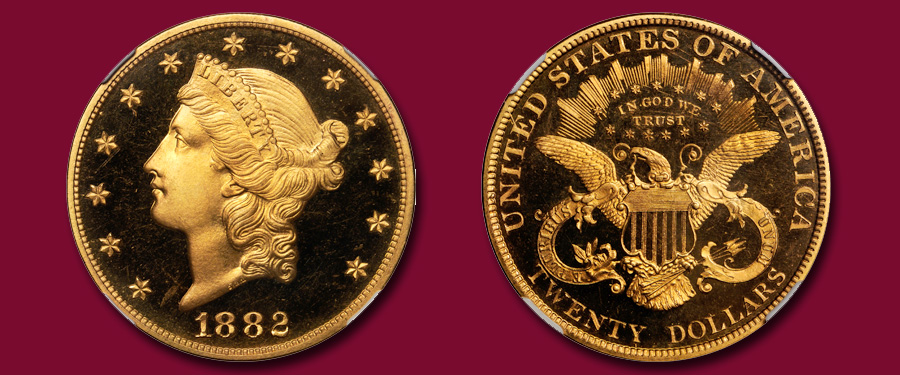
This extraordinary 1882 Proof double eagle is graded Proof-65 Ultra Cameo by NGC and offers dramatic cameo contrast. Glassy, deeply reflective fields form a splendid backdrop to fully defined, frosty textured devices on both sides. The lack of distracting marks is particularly desirable in the fields since it allows full appreciation of the handsome "orange peel" texture for which many later date Proof Liberty gold coins are known. The original Proof mintage for the 1882 double eagle was 59 pieces. From that small issue, perhaps 13 to 15 survive today in all grades; this Gem example is clearly one of the finest known. Furthermore it offers the exquisite Ultra Cameo contrast between the perfectly mirrored fields and highly frosted devices. As so few Proof double eagles were struck in 1882, the dies retained their polish and most of the Proofs were imparted with either the Cameo or Ultra Cameo contrast. Worthy of note is the fact that this is also a low mintage date for the regular issue with a mere 590 pieces struck for circulation, creating one of the key dates of the Liberty double eagle series. There is a single 1882 Proof double eagle certified a point finer by NGC with the Ultra Cameo contrast, and their Census notes two coins at this grade level. The website CoinFacts notes two examples they consider to be Proof-65 Deep Cameo and possibly three others as Proof-64 Deep Cameo, so this example is certainly one of the finest of this select group.
Precisely how the “orange peel” effect was created on these early Proof coins has been subject to considerable speculation. Noted researcher John Dannreuther has discovered that Proof coin planchets were first heated prior to striking, and this process helped to create the “orange peel” effect. The fields appear as perfectly smooth as glass when examined — yet they also appear to have a texture that looks much like the peel of an orange. Most Proof gold coins, as well as other Proofs, show the “orange peel” texture when closely examined.
When you hold this jewel in your hands recall the history that was unfolding in 1882. The famed outlaw Jesse James was gunned down for the sizable reward money offered — by his fellow outlaw Robert Ford in his own residence in St. Joseph, Missouri. Meanwhile, the march of progress lit up Manhattan, as Thomas A. Edison started the world’s first commercial electric power plant and provided power to light up an entire square mile of lower Manhattan. This early development required further refinements, as only 59 customers were served by this initial power distribution company. At the time, Edison believed that direct current was the better system to use in Manhattan in 1882. However, as time and economy have dictated, the alternating current electrical system proved to be cheaper to deliver and more efficient, and thus became the adopted standard in later years. This was a rapidly changing era, with each day filled with change and opportunity for those with ideas and capital.
The year 1882 brought the passing of Henry Wadsworth Longfellow and Ralph Waldo Emerson, and at the other end of the life spectrum Franklin Delano Roosevelt was born in this year. John D. Rockefeller formed Standard Oil of New Jersey, as well as the Standard Oil Trust, to oversee what would become one of the most powerful corporations in America.
NGC Census: just 2, only 1 finer (Proof-66 Ultra Cameo finest).





